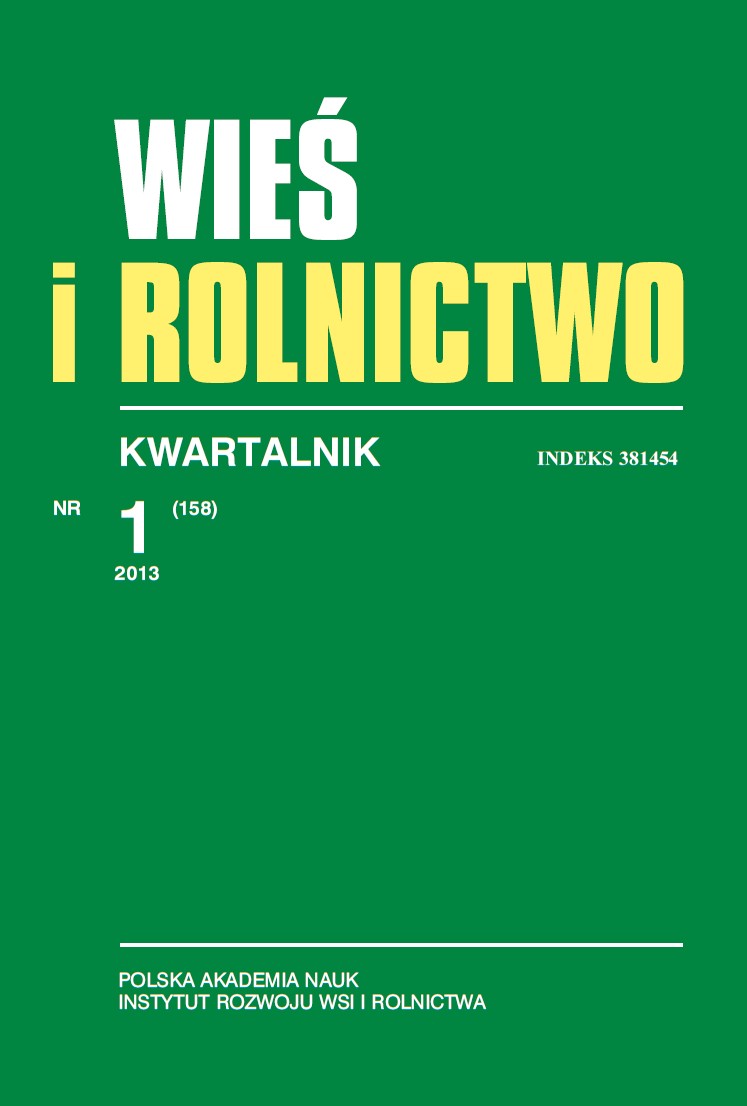The use of cluster analysis in the classification of similarities in variables associated with agricultural greenhouse gases emissions in OECD countries
DOI:
https://doi.org/10.53098/wir.2013.1.158/03Keywords:
cluster analysis, k-means method, Ward’s method, greenhouse gases, agriculture emissionsAbstract
The aim of the research was to group members of the Organization for Economic Co-operation and Development (OECD) into homogeneous subsets for similarities of agricultural variables affecting greenhouse gas emissions. Cluster analysis, which is a tool for exploratory data analysis, was used. This method is based on grouping of elements in a relatively homogeneous class. The most popular non-hierarchical clustering method is k-means. The method is based on an initial a priori assumption of input data set to a predetermined number of classes. In order to verify if the number of clusters was assumed properly, results were compared with another method of cluster analysis – a hierarchical method. Ward’s method of classifying on the basis of minimizing the interclass variance was used. Countries qualified for each cluster derived using k-means were identical to those obtained using Ward’s method. Analysis of the results lead to the conclusion that the geographical location of the countries was key to its inclusion in a cluster this was shown clearly in cluster 1 (Finland, Iceland, Norway, Sweden, Canada), cluster 2 (Austria, Czech Republic, Poland, Slovakia, Switzerland) and cluster 4 (Australia, New Zealand). Group 3 is a 15-element set of countries in predominantly highly industrialized regions.References
Caldeira K., Morgan M.G., Baldocchi D., Brewer P.G., Chen C.T.A., Nabuurs G.J., Nakicenovic G.J., Robertson G.P., 2004: A portfolio of carbon management options. In: C.B. Field, M.R. Raupach (ed.). The Global Carbon Cycle. Integrating Humans, Climate, and the Natural World. SCOPE 62, Island Press, Washington DC: 103–129.
Grabiński T., 1992: Methods of axonometry. Akademia Ekonomiczna w Krakowie, Kraków.
Green R.E., Cornell S.J., Scharlemann J.P.W., Balmford A., 2005: Farming and the fate of wild nature. “Science” 307: 550–555. DOI: https://doi.org/10.1126/science.1106049
Hand D., Mannila H., Smyth P., 2005: Data Mining. WNT, Warszawa. DOI: https://doi.org/10.1002/0470011815.b2a00007
Jarvis S.C., Pain B.F., 1994: Greenhouse Gas Emissions from Intensive livestock Systems: Their Estimation and Technologies for Reduction. “Climatic Change” 17 (1): 27–38. DOI: https://doi.org/10.1007/BF01098471
Kaufman L., Rousseeuw P. J., 2005: Finding groups in data: an introduction to cluster analysis. Wiley, New York.
Klimont Z., Brink C., 2004: Modelling of Emissions of Air Pollutants and Greenhouse Gases from Agricultural Sources in Europe. Interim Report IR-04-048, International Institute for Applied Systems Analysis, Luxemburg.
Li C., Frolking S., Xiao X., Moore B., Boles S., Qiu J., Huang Y., Salas W., Sass R., 2005: Modelling impacts of farming management alternatives on CO2, CH4, and N2O emissions: A case study for water management of rice agriculture of China. “Global Biogeochemical Cycles” 19 (3), doi:10.1029/2004GB002341. DOI: https://doi.org/10.1029/2004GB002341
Metz B., Davidson O.R., Bosch P.R., Dave R., Meyer L.A. (ed.) 2007: Climate Change 2007: Mitigation of Climate Change. Contribution of Working Group III to the Fourth Assessment Report of the Intergovernmental Panel on Climate Change. Cambridde University Press, Cambridge, United Kingdom and New York, NY, USA.
Migut G., 2009: Application of techniques cluster analysis and decision trees for market segmentation. Statsoft Polska.
Ostasiewicz W., 1998: Statistical methods for data analysis. Akademia Ekonomiczna we Wrocławiu, Wrocław.
Pathak H., Li C., Wassmann R., 2005: Greenhouse gas emissions from Indian rice fields: calibration and upscaling using the DNDC model. “Biogeosciences” 2, 113–123. DOI: https://doi.org/10.5194/bg-2-113-2005
Pietrzak S., 2009: Formation of the nitrogen cycle in macro-and microsystems farming. “Water – Environment – Rural Areas” 9, 3 (27): 143–158.
Shih J.S., Burtraw D., Palmer K., Siikamaki J., 2008: Air Emissions of Ammonia and Methane from Livestock Operations: Valuation and Policy Options. Air & Waste Management Association, Washington. DOI: https://doi.org/10.3155/1047-3289.58.9.1117
Smith P., Martino D., Cai Z., Gwary D., Janzen h.H., Kumar P., McCarl B., Ogle S., O’Mara F., Rice C., Scholes R.J., Sirotenko O., Howden M., McAllister T., Pan G., Romanenkov V., Schneider U., Towprayoon S., Wattenbach M., Smith J.U., 2008: Greenhouse gas mitigation in agriculture. Philosophical Transactions of the Royal Society of London. B 363, 1492, 789–813. DOI: https://doi.org/10.1098/rstb.2007.2184
Sokołowski A., 1992: Empirical significance tests in the taxonomy. Akademia Ekonomiczna w Krakowie. Zeszyty Naukowe. Monografie 108.
Tadeusiewicz R., 2006: Data mining as an opportunity for relatively cheap carrying out scientific discoveries through digging seemingly fully exploited empirical data. In: Statistics and Data Mining in research. Ed. J. Wątroba. StatSoft, Kraków.
Downloads
Article file downloads
Pages
How to Cite
Issue
Section
License
Copyright (c) 2013 Wieś i Rolnictwo

This work is licensed under a Creative Commons Attribution 4.0 International License.










